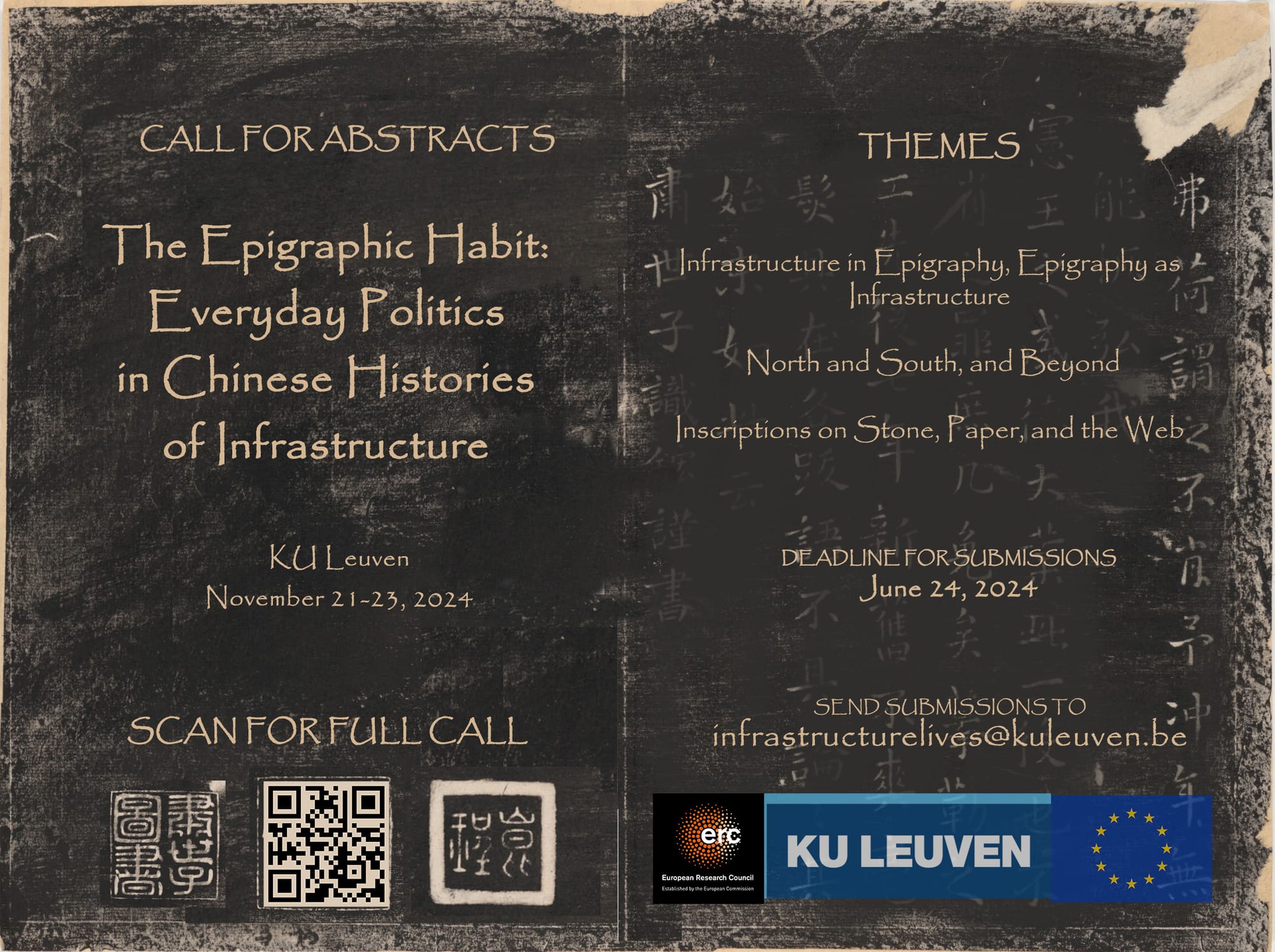
Organized by the ERC-research project 'Regionalizing Infrastructures in Chinese History' (KU Leuven, Belgium)
Organizers: Sunkyu Lee, Marco Wing-Yin See, Dawn Lizao Zhuang, and Hilde De Weerdt
Date: November 21-23, 2024
Location: KU Leuven, Belgium
Abstracts Deadline: June 24, 2024
Contact: Sunkyu Lee ([email protected])
The “infrastructural turn” has prompted scholars to consider infrastructure not only as the physical structures that provide basic services, but also as the frameworks that maintain connections between different actors and institutions across spaces, and thus wield power and exert lasting influence (Bridges 2023). Despite the growing emphasis on infrastructure in historical scholarship, few studies in East Asian history have critically and systematically examined infrastructural epigraphy. Hundreds of steles and rubbings have survived documenting infrastructural events, including the construction, repair, and destruction of bridges, walls, and roads in imperial Chinese history. Compared to other written sources, stele inscriptions have distinct advantages for analyzing the role of local actors and institutions in infrastructural history. This conference invites scholars from various fields of inquiry, including history, historical anthropology, art history, archaeology, religious studies, and digital humanities, to explore the use of epigraphic sources in comparative and transregional histories of infrastructures.
This conference addresses three broad themes. First, we ask why it is necessary to study infrastructure through epigraphy, and whether epigraphical objects can also be seen as a type of infrastructure that creates social connections or boundaries. Second, we aim to discuss different regional and transregional patterns of infrastructural development and contraction and compare epigraphic materials from different regions and localities. Third, adopting the recent emphasis on materiality in infrastructure studies, we explore how different material forms have shaped the meaning and interpretation of inscriptions and examine historical and spatial patterns in epigraphic circulation and reception. In addition, we aim to enhance the understanding of how the recent digitization of epigraphic ojects has affected their study and the study of their material forms in particular.
We invite scholars at different stages of their careers to present work on any of these questions. If you would like to contribute a paper, please submit a current cv and abstract (approximately 200 words) by June 24, 2024. Abstracts should be addressed to Sunkyu Lee ([email protected])
THEME 1. Infrastructure in Epigraphy, Epigraphy as Infrastructure
- What can the critical examination of epigraphic materials contribute to the study of infrastructure in late imperial Chinese history? What are the limitations of these materials and their transcriptions? In what ways do epigraphic sources reveal power relations among the various actors involved in the planning, construction, use, or destruction of infrastructures? Do these sources allow us to write about the everyday engagement of ordinary people with infrastructures?
- Can infrastructural epigraphy be considered a genre distinct from other forms of epigraphy? If so, what methodologies are needed to study the development of the genre of infrastructural epigraphy and its interaction with other epigraphic genres?
- In what ways did infrastructural epigraphy shape the development of infrastructure and shape the way in which people thought about and used infrastructure?
- Can infrastructure be used as a conceptual framework to analyze epigraphic sources? In what ways did epigraphic objects facilitate connections between actors across regions?
THEME 2. North and South, and Beyond
- What do steles reveal about the relationships between the different actors and institutions involved in infrastructural works? How have different local dynamics affected the construction and management of different types of infrastructure?
- How did local actors use steles to make claims, to organize social groups, or to resolve disputes over the use and management of infrastructure?
- What local and regional patterns can we discern in the use of steles to commemorate events related to the construction and repair of infrastructures? How do epigraphic studies challenge our existing notions of spatial organization and enhance our understanding of regional diversity and interconnectedness in pre-twentieth-century China and East Asia?
- How can we combine diverse historical and archeological materials, including steles, genealogies, gazetteers, oral histories, and archeological reports and engage with local communities and environments to study the dynamics of East Asian society across regions and historical periods?
THEME 3. Inscriptions on Stone, Paper, and the Web
- How have steles interacted with their environments, activities, and spaces? How did such interactions change over time? How can we best explain changes in the physical and visual aspects of steles, such as their layout, size, and format?
- How did the materiality of stones affect the cultural meanings embedded in them? How did different actors adapt stone as a medium for different social needs and political ends?
- How did the contents of inscriptions change when they were removed from their original context (physically when the stone was moved from its original site; and also materially when the image was transferred to paper through ink rubbings or the text transcribed in gazetteers and other literary compilations)? What sources or methods could help us reconstruct the spatial contexts of stone stelae?
- How were different material formats of inscriptions (stone steles, rubbings or facsimiles and transcribed texts) received? What kind of meanings and functions did they acquire as their materiality changed, and how did this changing materiality affect the patterns of their use and circulation?
For further information, please contact Sunkyu Lee ([email protected]).